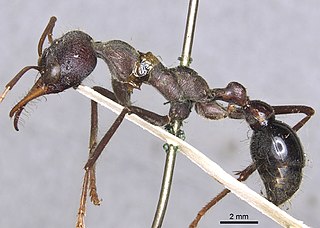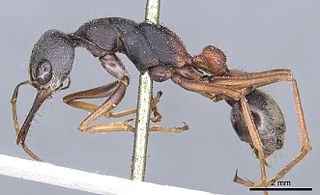
Myrmecia vindex is a species of Myrmecia which is endemic to Australia. As a subgroup of the Myrmecia gulosa species group, these ants are also commonly known as the Bull Ant. The Myrmecia vindex was collected and described by Frederick Smith in 1858.

Myrmecia pyriformis, also known as the bull ant or inch ant, is an Australian ant. Myrmecia pyriformis belongs to the genus Myrmecia. It is abundant in many major cities of Australia, but mostly spotted in the eastern states. The species is of a similar appearance to the Myrmecia forficata.

Myrmecia nigrocincta, commonly known as the jumper ant or jumping jack, is an ant of the genus Myrmecia. The species was first described by Frederick Smith in 1858. Colonies of this ant are abundant in eastern Australia. Ants of this species are known for their ability to jump up to 10 centimetres, and they also have a powerful, venomous sting. Rather than foraging on the ground, M. nigrocincta prefer to forage in trees where they are known to pollinate certain flowers.

Myrmecia gratiosa is an Australian ant which belongs to the genus Myrmecia. Native to Australia, this species is mainly found in Western Australia. During a study in Perth, it was realised that Myrmecia gratiosa was located in all locations where reactions in patients occurred. This concludes the species was responsible for ant sting anaphylaxis around Perth.

Myrmecia tarsata is a bull ant species native to Australia. The species belongs to the genus Myrmecia. Their distribution is large, mainly around New South Wales and the Australian Capital Territory.

Myrmecia auriventris is an Australian ant which belongs to the genus Myrmecia. This species is endemic to Australia and is commonly distributed in Queensland.

Myrmecia picta is an Australian ant which belongs to the genus Myrmecia. It is native to Australia. Myrmecia picta is distributed throughout all of Australia.

Myrmecia clarki is an Australian ant which belongs to the genus Myrmecia. This species is endemic to Australia and is commonly distributed in Western Australia. The average length for this species is typically around 16-16.5 millimetres long. Males are smaller at 11-12 millimetres long and queens are normally bigger. They are similar to the jack jumper ant. They are mostly black, with the exception of their mandibles being yellow and the legs being blackish-brown.
Myrmecia dimidiata is an Australian ant which belongs to the genus Myrmecia. This species is native to Australia. The Myrmecia dimidiata is distributed in the eastern states of Australia.

Myrmecia piliventris, the golden tail bull ant, is an Australian ant which belongs to the genus Myrmecia. This species is native to Australia. The Myrmecia piliventris is distributed Australia wide, but they're not too common in the western regions of Australia.

Myrmecia simillima is an Australian ant which belongs to the genus Myrmecia. This species is native to Australia. Their distribution in Australia is massive on the coastline and inland areas of New South Wales and Victoria.

Myrmecia chasei is an Australian ant which belongs to the genus Myrmecia. This species is native to Australia. The Myrmecia chasei has a large presence and distribution in the south-eastern areas of Western Australia.

Myrmecia testaceipes is an Australian ant which belongs to the genus Myrmecia. This species is native to Australia. The distribution of Myrmecia testaceipes is throughout all of the southern states of Australia. It was described as a species by John S. Clark in 1943.

Myrmecia froggatti is an Australian ant which belongs to the genus Myrmecia. This species is endemic to Australia. This species is distributed throughout all areas of New South Wales and elsewhere up north and south.

Myrmecia fuscipes is an Australian ant which belongs to the genus Myrmecia. This species is native to Australia. Their distribution is heavily observed in South Australia and Western Australia.

Myrmecia athertonensis is an Australian ant which belongs to the genus Myrmecia. This species is endemic to Australia. They are commonly spotted in the north of Queensland. It was described by Forel in 1915.
Myrmecia maura is an Australian ant which belongs to the genus Myrmecia. This species is native to Australia. Their distribution in Australia is mostly around the Australian Capital Territory and New South Wales.

Myrmecia swalei is an Australian ant which belongs to the genus Myrmecia. This species is native to Australia and is commonly distributed in Western Australia and South Australia. It was described by Crawley in 1922.

Myrmecia varians is an Australian ant which belongs to the genus Myrmecia. This species is endemic to Australia. The Myrmecia varians is one of the most distributed ants in the country, with the species being observed in every single state and territory except for Tasmania. Myrmecia varians was first described by Mayr in 1876.

















